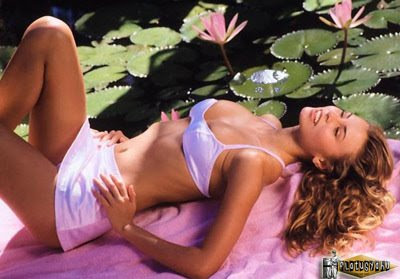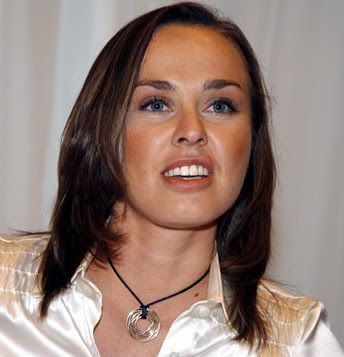Martina Hingis was born in Kosice, Czechoslovakia (now Slovakia), on 30th September, 1980. She was born Martina Hingis due to her father, Karol Hingis. At this time, her mother was joined in matrimony, and thus named Hingis, but she has since changed her name twice, to Zogg, and its present incarnation, Molitor. This is her maiden name. She changed her name to Zogg when she married a Swiss computer salesman named Andreas Zogg, but this relationship has subsequently dissolved, rather acrimoniously.
Melanie Molitor was a capable tennis player herself. It is broadly accepted that it was her who hatched the plan to make her daughter a star, though there is some debate that Karol may have had some influence in starting Martina off. That is not the version that Melanie remembers, she states that she placed a sawn-off wooden racquet in little Martina's hand for the first time when she was just two. Martina and mother played tennis together for ten minutes a day at this time.
Molitor had been ranked as highly as ten in her native Czechoslovakia during her youth. It was clear she relished her life within the game, but she simply didn't have the talent to reach the WTA Tour, to make a considerable living out of the game. Molitor's own tennis career had some major influences on Martina. Her hero was Martina Navratilova, though Molitor was clearly jealous of the freedom that tennis gave to her hero. Navratilova prompted Molitor to name her daughter Martina, and she vowed to give her daughter the opportunity to go wherever she wanted, and to have financial independence.
Also, Molitor was primarily a baseliner, and she was determined to make Martina an all-court player, capable of playing any shot in the game. It is clear that Molitor's family history had a considerable influence on her determination for her daughter to have a fruitful life. Molitor's personal life was shaped profoundly by politics in Czechoslovakia. Her father, and Martina's grandfather, was a landscape architect, and an ardent anti-Communist.
He was sentenced to eight years of hard labor, working at a uranium mine that essentially amounted to a concentration camp. In essence, he was imprisoned, purely for opposing the government politically. The Communist party had intended to break him, in an eternal attempt to crush Communist opposition. Molitor cites her father as the most important person in her life, the one who had the greatest influence on her. His refusal to compromise, and determination to stand up for what he believed in, has clearly had a huge influence on Molitor's fiery temperament. And the freedom that he was denied convinced her to give Martina every opportunity to be as free as possible.
Her father died in 1988, one year before Communism died in Czechoslovakia. Molitor says he was, apart from her, the only one who believed in Martina. Tennis was still very much part of Molitor's life when she met Karol Hingis, who has also been a player and coach. They married and set up house in Kosice, and had their only child, Martina, in 1980. Unfortunately they divorced four years later, in rather angry circumstances, the details of which remain firmly private. They will not communicate at all now.
Molitor and Hingis moved to Roznov, Czechoslovakia, with Martina's grandfather seriously ill, a bitter divorce behind them, little money and no occupation. It was now that Martina's hitherto difficult life was to take a turn for the better. She could already hit the ball back and forth 300 times. In Roznov, Hingis begun to play tennis prolifically. Martina says that the divorce was the worst time of her life. And she has hardly seen her father since it happened.
Her father is now a groundskeeper at the local tennis club where he lives, earning approximately Ј8,500 per annum. His daughter is a world famous, multi-Grand Slam winning tennis player, who was paid Ј8,500 by Sergio Tacchini every two days. For the record, Hingis still sees her father, making time to visit him at least once a year. There are rumors that Karol Hingis walked out on Martina and Melanie, and that the break-up of the marriage was not mutual, but these are unsubstantiated.
Typically, Martina does not resent her father, indeed she says they have "a great relationship", and that "he wants the best for [her]". It would appear that Hingis and Hingis are rather more alike in character than Hingis and Molitor, both of them are laid-back people. Had Martina taken up residence with her father, she probably would not have become the success she has. I cannot imagine Martina working in a factory or an office. Perhaps she would have worked with horses in some capacity. Such speculation is irrelevant, however, because Martina did indeed go off with her mother, to begin a new life in Roznov.
"Since I was in her stomach my mom was thinking I was going to be a great tennis player". Well, at Roznov, Martina's tennis practice began in earnest. Martina begun to play at the local tennis club, and what had been a turbulent life suddenly became a happy one. "I just loved it. I didn't want anything else in the world. We had a small apartment, which I liked, and we were always on the courts playing tennis. We had fun".
By five, Martina was playing tennis for up to five hours a day, considerably longer than she plays now. She entered her first tournament at four, and by the time she was six, she could be beaten by no-one under the age of nine. Most importantly for a young girl, she had esteem and belonging. "I just had a great life out there. There were always 40 kids on the grounds. It was like a big family together, like one big community. I just grew up on the courts. I would go to the courts with my mom, and when she practiced, I was there. I would play for four hours, then play a soccer game in the evenings, and then go home and hit the ball on the wall of our apartment. I was crazy!"
Martina also sparked her passion for horse riding when her mother took her to ride a pony, aged just four. She loved it instantly, and now lists horse riding as her main passion in life. She was also able to go and see her grandmother and father whenever she wanted to, and often went over to the courts for lunch, as their house was near the courts. But when she was seven, Martina was again uprooted, as her mother married Andreas Zogg, and moved to Switzerland.
Her new residence has been her home for years since, it was the beautiful town of Trubbach. In some senses Martina had landed on her feet, Trubbach is just the most gorgeous place you can imagine, and an unassuming girl was well suited to life in the tiny hamlet. Her laid-back attitude was also reflected in the attitudes of her new compatriots. It was obviously not an ideal thing for a seven year-old girl to start all over again in a new country. But Hingis was nothing if not resolute. She refused to be held back a year, and was thrust straight into the second grade.
At first Martina could barely understand a word that was being said. She would return from a day's schooling to announce to her mother that she had no idea what they had been doing. "I wasn't very happy to go to school at first". But within three months, Martina was fluent in Swiss-German, and she now appears as Swiss as any girl, and is as eloquent in German as in Czech.
When asked in Melbourne in 1997, how Slovakia would react to her Australian Open victory, she responded by saying that she was Swiss, Switzerland was her country, and that she was unrelated to Slovakia, now. "I was determined to learn and make friends, which I did in time". Hingis is, in my opinion, a fine linguist. She speaks four languages, and I feel bound to say that her English is excellent. She could not speak any English until she was 12, yet it needs only a second for her to describe her mother as undiplomatic. I really admire anyone who can learn English; it is a language without rule or reason.
Martina first defeated her mother when she was ten years old, and throughout her younger years won a succession of Swiss titles, until, when she was 11, she was the under-18 champion of Switzerland. Next year she won the adult Swiss championship. It was clear that Martina was going to have a career in tennis, and a sparkling future was predicted when she became the youngest girl to win a junior Grand Slam, at the French Open, when still only 12.
So, by the time she was 14, having left school, Martina was ready for professional tennis. She entered her first professional tournament on 3rd October, 1994, in Zurich, a mere 50 miles from her home. In her very first professional event she upset American veteran Patty Fendick in straight sets, and caused a young Mary Pierce considerable discomfort in the second round. She reached two quarterfinals in her next two events, and upset former top-ten player Helena Sukova.
By the end of 1994, Martina Hingis had broken into the world's top 100. A career had begun that was to bring achievement, glory, fame, admiration and wealth. And freedom.
And such has been the nature of her life that a rather splendid young lady had been forged, a charming, self-aware, spontaneous girl, who realized just how lucky she was, and was determined to enjoy and cherish what she had. This girl had no bitterness toward her father, ultimate respect and gratitude for her mother, and the desire and passion to learn and experience and prosper. And she was about to prosper profoundly in the sphere of tennis... martina hingis biography 2
martina hingis biography 2 martina hingis biography 4
martina hingis biography 4






